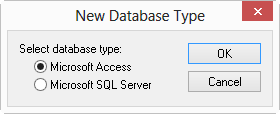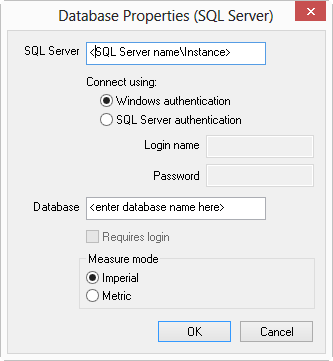
6.01.02 Creating a Microsoft SQL Server Database

Microsoft SQL Server is a robust server application that provides a multi-user environment with enhanced security, performance, and stability. If you need to share your database or store it on a network, you must use SQL-type databases. SQL is NOT included with Quick Bid, it is a separate product available from Microsoft.
See the previous article, Creating a Microsoft Access (default) Database, for instructions on setting up an Access-type (default) database.
This document details how to setup and create an SQL database for use with Quick Bid. The steps are basic and easy to follow, however On Center Software, Inc. recommends that only IT professionals with knowledge of the server environment and with appropriate expertise in server configuration and administration perform these actions. In some cases, a server may have been configured in a way that would require additional steps not detailed in this process. On Center Software, Inc. provides these instructions as a resource for our customers but you are solely responsible for implementation, maintenance, troubleshooting, and configuration of SQL Servers and databases.
On Center Software, Inc. does not provide technical support for SQL server setups, assist in the administration, maintenance, configuration, or troubleshooting of an SQL server performance, network connectivity, or any other issues directly related to SQL Server. For assistance with managing your SQL Server installation, please contact the vendor from whom you purchased SQL Server or contact Microsoft directly.
This document assumes that a supported version of Microsoft SQL Server™ is already installed on a server that meets (preferably exceeds) the system requirements for SQL Server™. If SQL is not currently installed, we recommend that a certified IT professional assist with the SQL setup and configuration.
Before proceeding, please review our Web site for current information on using Microsoft SQL databases Recommendations for implementing SQL Server. On Center Software ONLY tests and certifies certain versions of SQL Server for each version of the software - what worked in the past may NO LONGER BE SUPPORTED.
The SQL database is created from within Quick Bid - not from the SQL Management Console.
There are several editions of SQL Server available from Microsoft - you need to determine the edition (Free, Full, Enterprise, etc.) that meets your particular needs. On Center recommends you contact a qualified IT Professional to discuss your needs based on the number of users, your network environment, how you bid jobs, and other software that may be running on your server.
There are two ways to authenticate to (log into, connect to) a SQL Server:
Windows Authentication passes the user's Windows logon and password to the SQL Server to make it easier for the users to use the SQL Server database (this is the recommended authentication method)
SQL Server Authentication requires the SQL Admin create SQL Logins for all users and manage these user IDs and passwords separate via SQL Server Management Studio. On Center provides no assistance with setting up or maintaining user names and passwords. Each user should have a unique SQL sign on whether Windows or SQL Authentication is used.
Once a new SQL database is created you can synchronize it with an existing Access-type database and copy Bids to it (see below for more information). Your database will be ready to use in minutes!
Only users with appropriate permission (SQL Server Administrators and dbo's) should attempt to create or upgrade SQL databases. Attempting to modify an SQL database if you do not have sufficient SQL rights may render the database unusable.
It is not necessary to install Quick Bid on the server although for future database maintenance, it is permitted. The Quick Bid application must be installed on the workstation on which the following steps are completed.
Quick Bid is not a Client-Server application - it cannot be used in this manner and must be installed on each user's workstation or in a Citrix/Terminal Server environment.
Open the existing Access (*.mdb) database to which the new SQL database is to be synchronized.
It is recommended that only one database is synchronized to another database. Synchronizing multiple databases into a single database causes information to be overwritten.


Type the name of the SQL Server\Instance in the SQL Server field (On Center Software is unable to provide this information - contact the SQL or Network Administrator for assistance)
Select appropriate server authentication under Connect using (if using SQL Authentication, type in the Login Name and Password provided by the SQL Server Administrator)
Enter a name for the new Database in the Database field
Database names must not contain special characters such as the following symbols: \ / : * ? ’ ; < >; only standard alpha-numeric English characters should be used. (Anything that is not an English letter or number should be avoided when naming databases or projects.)
The "Requires login" option is only available after the database is created. To make the database password protected, follow these steps to create it, add appropriate estimators to the database, then come back to Database Properties and check the box for this feature. See Logging into a Database for more information.
In the Measure mode field, select either Imperial or Metric as the system of measurement to use, see Units of Measurement (UOM) for more information. All UOM boxes in the application are based on this setting - Imperial bids must be stored in an Imperial database, metric Bids in a Metric database.
Click OK
The database is available and listed on the Bids Tab (and in the Bids Navigator panel where any existing, open databases are visible).
Notice - there are no Auto-Backup or Auto-Compress options for SQL databases because On-Screen Takeoff cannot perform automatic maintenance on an SQL Database. Your SQL Administrator is responsible for performing routing maintenance on SQL databases in accordance with good business practices. Regularly running the Compact & Repair routine, described in, Database Maintenance - Compact and Repair, is required to keep your database in tip-top shape.
Please follow these steps in Synchronizing Databases to copy the Master Tables from a previous database to this new SQL database.
Remember, synchronizing only transfers Master Database Tables information from one database to another, no bids are copied.
To copy bids from your Access database(s) to the SQL database, both databases must be visible on the Bids tab, see Opening and Closing Databases. Then, it's just a matter of copying and pasting, see Copying Bid(s) for instructions.
Move the Access (*.mdb) database to a folder, CD, or Flash Drive that is not shared nor visible to the user(s). Consider this an archive of previous work and should only be accessed for those purposes.
If you leave the Access (*.mdb) database visible, you risk your end users accidentally opening the outdated Microsoft Access database and creating Bids in the wrong database or modifying archival Bids.
You can skip right to Creating Bids at this point, see Creating Bids as many database settings can be built 'on-the-fly' although we recommend you take your time and learn about properly setting up Payroll Settings, Program Defaults, and Bid Markups & Indirect Expenses before continuing.